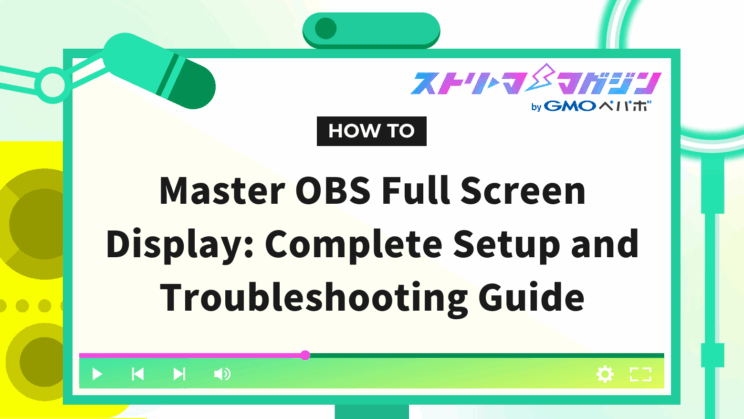Master OBS Full Screen Display: Complete Setup and Troubleshooting Guide

Index
- How to Display Full Screen in OBS
- Common Troubles with OBS Full Screen and How to Solve Them
- How to Upgrade Your Streaming Environment Using OBS’s Full Screen
- Frequently Asked Questions About Full-Screen Display in OBS
Even after installing OBS for streaming, many people find themselves struggling with how to display the screen at a larger size.
You might encounter difficulties during initial setup, but once you learn the proper steps, it becomes much easier to handle. Achieving the desired visuals can significantly enhance the quality of your streams.
This article introduces settings for full-screen display in OBS, solutions to common issues, and ways to enrich your streaming environment.
Try the methods for full-screen display to create a comfortable streaming environment.
How to Display Full Screen in OBS
Being able to enlarge the footage when using OBS makes it easier to check details. You can quickly zoom in on previews and scenes, making it easier to visualize the composition of your stream.
You can display three types of full screens in OBS:
- Preview
- Scene
- Source
Let’s explain how to display each one in full screen.
How to Display Preview in Full Screen
When checking the screen in OBS, a small preview can make it hard to see subtle positions or color nuances.
If you want a larger view, using the projector feature to go full screen is convenient.
It’s also useful for reviewing the brightness of the video or the UI layout before starting a game stream.
1. Right-click on the preview
2. Choose “Fullscreen Projector (Preview)” from the menu
3. If you want to confirm on a window, select “Windowed Projector (Preview)”
4. Specify the monitor for display
To exit full screen, press the Esc key.
How to Display Scene in Full Screen
If you’re using multiple scenes in OBS, going full screen on a per-scene basis makes it easier to grasp the layout and timing of transitions.
1. Select and right-click the target scene from the list
2. Click “Fullscreen Projector (Scene)” (specify the destination monitor)
⇒ For window display, use “Windowed Projector (Scene)”
3. Select the monitor to set it to full screen
To exit, press the Esc key.
How to Display Source in Full Screen
This is useful when you want to enlarge just a specific source. It’s recommended for those who want to check facial expressions by maximizing a webcam feed.
1. Right-click on the preview
2. Select “Fullscreen Projector (Source)”
⇒ For window view, use “Windowed Projector (Source)”
3. Specify the output monitor
Enlarging a single source can make it easier to notice image quality issues or subtle misplacements, so give it a try.
Common Troubles with OBS Full Screen and How to Solve Them
Attempting to display OBS in full screen may lead to issues where the screen goes black or the captured images appear distorted.
Here’s a summary of specific symptoms and solutions.
| Symptom | Solution |
|---|---|
| Screen goes black | • Change compatibility mode settings • Modify graphic settings • Disable game mode |
| Capture source not displaying correctly | • Reset source transformation • Reconfigure source |
| Video not displaying properly | • Re-install |
Next, we’ll introduce specific solutions for each symptom.
Symptom 1: Screen Goes Black
When OBS is set to full screen, you might encounter a situation where nothing is displayed. Trying the following methods can often lead to improvements.
- Change “Compatibility Mode” settings
- Add OBS to “Graphic Settings”
- Disable “Game Mode”
Solution 1: Change “Compatibility Mode” Settings
Switching to an operation mode intended for an older OS might help prevent the screen from going dark when full-screened.
1. Right-click the OBS executable and open Properties
2. Select the Compatibility tab
3. Check “Run this program in compatibility mode for:”
4. Specify the target OS version
5. Click “Apply” and close the window
If the issue persists, revert the settings and try the next steps.
Solution 2: Add OBS to “Graphic Settings”
Altering how the GPU is utilized can make it easier for the video to display.
1. Enter “Graphic Settings” in the Windows search bar and open the menu
2. Choose desktop app and add the OBS executable (e.g., obs64.exe) via Browse
3. Change to prioritize performance and close settings
Solution 3: Disable “Game Mode”
The features built into Windows might conflict with OBS, preventing video from appearing.
1. Open Windows settings with “Win + I”
2. Go to the Gaming section and turn off “Game Mode”
The above steps should help prevent excessive resource allocation to games, stabilizing OBS streaming or recording.
Symptom 2: Capture Source Not Displaying Correctly
When the entire screen isn’t displaying correctly, the source or transformation tool settings might be causing trouble. Try these two methods:
- Reset “Source” Transformation
- Reconfigure “Source”
Solution 1: Reset “Source” Transformation
OBS has a transformation tool that allows for fine adjustments to the position and size of the video. Resetting the transformation might solve full-screen display issues.
The method involves right-clicking the source, selecting “Transform” → “Reset Transform”. It also restores the original state if there’s unwanted scaling or rotation.
Solution 2: Reconfigure “Source”
When source information is corrupted or incorrect properties are set, the capture may not work correctly. Deleting the source entirely and reconfiguring from scratch can be smoother.
If you’re capturing a full-screen game, the following is a general guideline:
1. Open OBS Studio, click the “+” button in the source list
2. Choose “Screen Capture”, enter a name, and click OK
3. Select the screen you want to record in the display capture properties
4. Uncheck “Capture cursor” if you don’t want to include it
5. If capturing a full-screen game, adjust settings to match the game
Symptom 3: Video Not Displaying Properly
If various methods fail to resolve the OBS full-screen issue, consider reinstalling OBS.
Exporting profiles and scene collections beforehand will reduce configuration burdens. Taking a backup and then reinstalling can effectively resolve problems.
How to Upgrade Your Streaming Environment Using OBS’s Full Screen
Leveraging full-screen functionality in OBS enhances video visibility and reduces streaming errors. Displaying game screens or presentation slides in full size improves the visual appeal of your streams.
This chapter explains three ways to upgrade your streaming environment:
- Display OBS full screen on a sub-monitor
- Optimize resolution and frame rate
- Combine chroma key function with full screen display
Display OBS Full Screen on a Sub-Monitor
Playing games on the main monitor while displaying OBS on another monitor makes stream management comfortable.
With one sub-monitor, you can verify the preview screen and settings thoroughly while continuing other tasks.
As an example, imagine playing an FPS game on the main monitor while positioning OBS on the sub-monitor to check your stream status in real-time.
The setup requires two monitors and a PC capable of handling both simultaneously. HDMI or DisplayPort can be utilized for connection.
By enabling the extended display mode in Windows or Mac, you can drag the OBS window to the sub-monitor.
The procedure to use the fullscreen projector feature in OBS is as follows:
1. Connect the monitor to the PC and enable the extended mode in the OS settings
2. Launch OBS and drag the window to the sub-monitor
3. Right-click the preview screen
4. Select “Fullscreen Projector (Preview)”
5. Specify the sub-monitor
Displaying OBS full screen on a sub-monitor maintains the visibility of the game screen on the main monitor while allowing you to monitor the streaming preview and volume meters on the sub side. This reduces eye movement, helping to prevent mistakes.
If a sub-monitor is unavailable, you can also use a laptop and an external monitor. Matching the screen height reduces physical strain over longer sessions, which is beneficial for those expecting extended streaming periods.
Optimize Resolution and Frame Rate
Even when using the fullscreen projector feature in OBS, if the base resolution remains low, the video may record at a small size.
By adjusting the base resolution to match the monitor environment, you can deliver clear videos at full HD or higher. This is ideal for fast-paced game streams or high-quality screen sharing sessions.
1. Open OBS, go to “File” → “Settings”
2. Select “Video”
3. Align the Base (Canvas) Resolution with the monitor resolution (e.g., 1920×1080)
4. Click “Apply” and “OK” to close the window
This enlarges the base canvas, making it easier to capture the entire full-screen display.
Set the frame rate to 60fps or 30fps according to the content being streamed. Fast-moving games benefit from 60fps, while 30fps is more manageable for slower-paced educational streams.
Combine Chroma Key Function with Full Screen Display
You can create visually appealing broadcasts by combining the chroma key and full screen features in OBS. Using a green screen cloth or panel, you can integrate only the person into the frame, enhancing the clarity of games or slide content.
1. Right-click and select “Filters” on the source you want to make transparent
2. Click the “+” button
3. Choose “Chroma Key” from the list
4. Set the background color to “green” and adjust with the slider
By right-clicking the preview and outputting “Fullscreen Projector (Preview)” to a sub-monitor or similar, you’re set.
Overlaying game capture or desktop footage lets you present as if you melted into the screen, adding context seamlessly.
In FPS streams, the player’s figure occupies a corner, minimizing obstruction. In seminar videos, it’s like the presenter stands next to the materials.
Combining OBS’s scene transition feature creates smooth transitions, enhancing the production quality. Using moves or fades introduces natural motions during transitions, leaving viewers with a positive impression.
If you wish to infuse your streams with personality, explore transition plugins like StreamFX for a richer experience.
For a more detailed explanation of chroma key settings, refer to the following article.
Chroma Key Compositing in OBS: Transparent Background Without Green Screen!
Frequently Asked Questions About Full-Screen Display in OBS
Some of you may still have unresolved questions about OBS full-screen display or monitor configurations. Those unfamiliar with computer operations might find themselves perplexed at times.
This chapter addresses frequently asked questions about OBS full-screen features. Check them out to ensure a smooth streaming experience.
Is There a Shortcut for Full-Screen Display?
OBS lacks a shortcut to instantaneously toggle between normal window and full-screen display. Pressing the Esc key remains the basic way to exit full screen mode.
How to Display Full Screen on Discord?
If you want to share OBS’s full-screen view while in an online call, here’s how:
1. Launch OBS and confirm the screen you want to capture in preview
2. Right-click the preview and click “Fullscreen Projector (Preview)”
3. For those with multiple displays, select the monitor to full-screen
4. Open Discord, join a voice chat and click “Share Screen”
5. From the displayed window list, select “Fullscreen Projector (Preview)”
To share audio too, check “Share application audio” and hit “Go Live.”
For higher-resolution sharing, consider using Discord Nitro for additional features. If you want the footage to be visible only to voice chat participants, utilize the option to hide the preview screen.
If you want to know more about OBS and Discord integration, check out the article below.
How to Share Discord Audio and Screen on OBS: A Complete Guide
This article explained how to utilize full-screen display in OBS and tackle common issues. By configuring it correctly, you improve screen visibility and streamline streaming operations. Thoroughly understanding full-screen display and keeping the following key points in mind is essential.
| Example Troubles | Solutions |
|---|---|
| Screen goes black | Change compatibility mode settings Optimize graphic settings Disable game mode |
| Capture source not displaying | Reset or reconfigure source transformation |
| Video not displaying properly | Reinstall and utilize backups |








